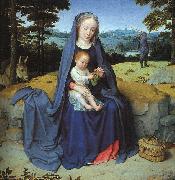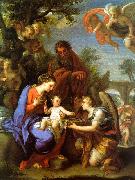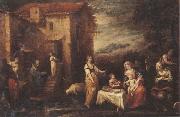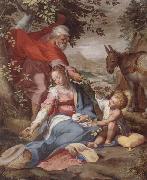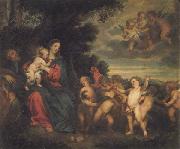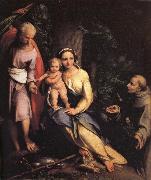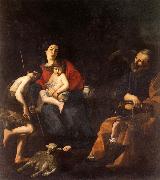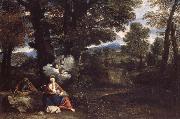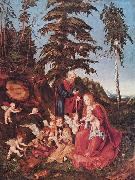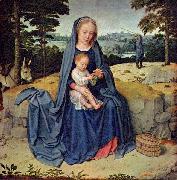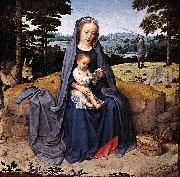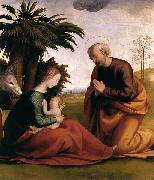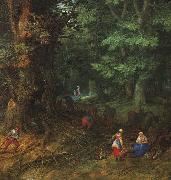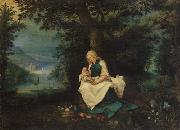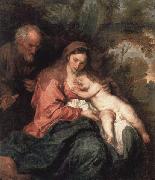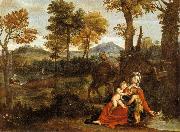Wholesale Oil Painting No Minimum |
|||||||||||
|
|
|||||||||||

|
|||||||||||
|
|
|
||||||||
Gerard Davidb.c. 1460, Oudewater, Neth. d.Aug. 13, 1523, Bruges Flemish Gerard David Locations Netherlandish painter. He is known as the last of the Flemish Primitives. Although born in the northern Netherlands, he moved to Bruges as a young man, and most of his work expresses the impassive, unmannered, microscopically realistic approach peculiar to south Netherlandish art in the time of Jan van Eyck. David was skilled at synthesizing the art of several important south Netherlandish predecessors, adapting, for instance, the compositions of van Eyck and the technique of Hugo van der Goes. He was also influenced by Hans Memling, whose example led him to refine and polish his cruder northern Netherlandish style and to adopt the popular theme of the Virgin and Child enthroned. |
||||||||
|
|
||||||||
The Rest on the Flight into Egypt
The Rest on the Flight into Egypt Painting ID:: 707 |
Metropolitan Museum of Art, New York Metropolitan Museum of Art, New York |
|||||||
|
|
||||||||
Chiari, GiuseppeItalian Baroque Era Painter, 1654-1727 |
||||||||
|
|
||||||||
|
|
The Rest on the Flight into Egypt
The Rest on the Flight into Egypt Painting ID:: 18931 |
oil on canvas, Calke Abbey, Derbyshire oil on canvas, Calke Abbey, Derbyshire |
||||||
|
|
||||||||
Francisco Antolinez y SarabiaSpanish Painter , Seville circa 1644-circa1700 |
||||||||
|
|
||||||||
|
|
The rest on the flight into egypt
The rest on the flight into egypt Painting ID:: 27505 |
mk56
oil on canvas
mk56 oil on canvas |
||||||
|
|
||||||||
|
|
||||||||
|
|
The rest on the flight into egypt
The rest on the flight into egypt Painting ID:: 27507 |
mk56
oil on canvas
mk56 oil on canvas |
||||||
|
|
||||||||
Anthony Van DyckDutch 1599-1641 Anthony Van Dyck Locations Flemish painter and draughtsman, active also in Italy and England. He was the leading Flemish painter after Rubens in the first half of the 17th century and in the 18th century was often considered no less than his match. A number of van Dyck studies in oil of characterful heads were included in Rubens estate inventory in 1640, where they were distinguished neither in quality nor in purpose from those stocked by the older master. Although frustrated as a designer of tapestry and, with an almost solitary exception, as a deviser of palatial decoration, van Dyck succeeded brilliantly as an etcher. He was also skilled at organizing reproductive engravers in Antwerp to publish his works, in particular The Iconography (c. 1632-44), comprising scores of contemporary etched and engraved portraits, eventually numbering 100, by which election he revived the Renaissance tradition of promoting images of uomini illustri. His fame as a portrait painter in the cities of the southern Netherlands, as well as in London, Genoa, Rome and Palermo, has never been outshone; and from at least the early 18th century his full-length portraits were especially prized in Genoese, British and Flemish houses, where they were appreciated as much for their own sake as for the identities and families of the sitters. |
||||||||
|
|
||||||||
|
|
The Rest on the Flight into Egypt
The Rest on the Flight into Egypt Painting ID:: 28850 |
mk65
Oil on canvas
52 3/4x73 3/4in
Pitti,Palatine Gallery
mk65 Oil on canvas 52 3/4x73 3/4in Pitti,Palatine Gallery |
||||||
|
|
||||||||
CorreggioItalian 1489-1534 Correggio Locations Italian painter and draughtsman. Apart from his Venetian contemporaries, he was the most important northern Italian painter of the first half of the 16th century. His best-known works are the illusionistic frescoes in the domes of S Giovanni Evangelista and the cathedral in Parma, where he worked from 1520 to 1530. The combination of technical virtuosity and dramatic excitement in these works ensured their importance for later generations of artists. His altarpieces of the same period are equally original and ally intimacy of feeling with an ecstatic quality that seems to anticipate the Baroque. In his paintings of mythological subjects, especially those executed after his return to Correggio around 1530, he created images whose sensuality and abandon have been seen as foreshadowing the Rococo. Vasari wrote that Correggio was timid and virtuous, that family responsibilities made him miserly and that he died from a fever after walking in the sun. He left no letters and, apart from Vasari account, nothing is known of his character or personality beyond what can be deduced from his works. The story that he owned a manuscript of Bonaventura Berlinghieri Geographia, as well as his use of a latinized form of Allegri (Laetus), and his naming of his son after the humanist Pomponius Laetus, all suggest that he was an educated man by the standards of painters in this period. The intelligence of his paintings supports this claim. Relatively unknown in his lifetime, Correggio was to have an enormous posthumous reputation. He was revered by Federico Barocci and the Carracci, and throughout the 17th and 18th centuries his reputation rivalled that of Raphael. |
||||||||
|
|
||||||||
|
|
The Rest on the Flight into Egypt
The Rest on the Flight into Egypt Painting ID:: 29879 |
mk67
Oil on canvas
48 5/8x41 15/16in
Uffizi,Gallery
mk67 Oil on canvas 48 5/8x41 15/16in Uffizi,Gallery |
||||||
|
|
||||||||
CARACCIOLO, Giovanni BattistaItalian Baroque Era Painter, ca.1578-1635 Italian painter. He was one of the greatest Caravaggesque painters and the founder of Neapolitan Caravaggism. His Liberation of St Peter (c. 1615; Naples, Pio Monte della Misericordia; ) and Christ Washing the Feet of the Disciples (1622; Naples, Certosa di S Martino; see fig. 2 below) are masterpieces of 17th-century Neapolitan art, and attain a powerful and tragic grandeur. |
||||||||
|
|
||||||||
|
|
The Rest on the Flight into Egypt
The Rest on the Flight into Egypt Painting ID:: 30004 |
mk67
Oil on canvas
80 11/16x73 1/4in
Pitti,Palatine Gallery
mk67 Oil on canvas 80 11/16x73 1/4in Pitti,Palatine Gallery |
||||||
|
|
||||||||
MOLA, Pier FrancescoItalian Baroque Era Painter, 1612-1666 Painter and draughtsman, son of (1) Giovanni Battista Mola. His most characteristic works are small, intensely romantic scenes from mythology, the Bible, and from works by the poet Torquato Tasso, set in landscapes inspired by Venetian art. Yet he also received important public commissions for frescoes and altarpieces, and in his mature work he achieved an impressive synthesis of 17th-century Roman gran maniera painting with the stronger chiaroscuro and richer palette of the 16th-century Venetian style. He was a prolific and versatile draughtsman, who drew for pleasure as well as in preparation for commissions; he was also a witty caricaturist, who mocked himself and his friends as much as more typical targets |
||||||||
|
|
||||||||
|
|
THe Rest on the Flight into Egypt
THe Rest on the Flight into Egypt Painting ID:: 43097 |
mk170
1630-1635
Oil on canvas
3.5x45.7cm
mk170 1630-1635 Oil on canvas 3.5x45.7cm |
||||||
|
|
||||||||
BLOEMAERT, AbrahamDutch Mannerist Painter, ca.1564-1651 Abraham Bloemaert (1566, Gorinchem - January 27, 1651, Utrecht), was a Dutch painter and printmaker in etching and engraving. Bloemaert was the son of an architect, who moved his family to Utrecht in 1575, where Abraham was first a pupil of Gerrit Splinter (pupil of Frans Floris) and of Joos de Beer. He then spent three years in Paris, studying under several masters, and on his return to his native country received further training from Hieronymus Francken. In 1591 he went to Amsterdam, and four years later settled finally at Utrecht, where he became dean of the Guild of St. Luke. He excelled more as a colourist than as a draughtsman, was extremely productive, and painted and etched historical and allegorical pictures, landscapes, still-life, animal pictures and flower pieces. Among his pupils are his four sons, Hendrick, Frederick, Cornelis and Adriaan (all of whom achieved considerable reputation as painters or engravers), the two Honthorsts, Ferdinand Bol and Jacob Gerritsz Cuyp. |
||||||||
|
|
||||||||
|
|
The rest on the flight into Egypt
The rest on the flight into Egypt Painting ID:: 83332 |
1632
Medium Oil on canvas
Dimensions 85 x 109.5 cm (33.5 x 43.1 in)
cyf 1632 Medium Oil on canvas Dimensions 85 x 109.5 cm (33.5 x 43.1 in) cyf |
||||||
|
|
||||||||
Lucas CranachKronach 1472-Weimar 1553 German painter and engraver. The son of a painter, he settled in Wittenberg c.1504 and was court painter successively under three electors of Saxony. There he maintained a flourishing workshop and was twice burgomaster. Cranach was a close friend of Martin Luther, whose doctrine he upheld in numerous paintings and woodcuts, and he has been called the painter of the Reformation. He was a rapid and prolific painter, and the work turned out by his studio is uneven in quality. Naïve and fanciful, often awkward in draftsmanship, it has, nonetheless, freshness and originality and a warm, rich palette. His portraits are particularly successful. Among his best-known works are Repose in Egypt (Gemäldgalerie, Staatliche Mus., Berlin-Dahlem); Judgment of Paris (Staatliche Kunsthalle, Karlsruhe); Adam and Eve (Courtauld Inst., London); and Crucifixion (Weimar). The latter contains figures of Luther and Cranach. His many famous protraits include those of Elector John Frederick and Self-Portrait (Uffizi). Cranach was also an accomplished miniaturist. He produced a few copperplates and designs for woodcuts. His son and pupil Lucas Cranach, the Younger, |
||||||||
|
|
||||||||
|
|
The Rest on The Flight into Egypt
The Rest on The Flight into Egypt Painting ID:: 86808 |
Date 1504(1504)
Medium Oil on wood
Dimensions 70,7 x 53 cm
cjr Date 1504(1504) Medium Oil on wood Dimensions 70,7 x 53 cm cjr |
||||||
|
|
||||||||
Gerard Davidb.c. 1460, Oudewater, Neth. d.Aug. 13, 1523, Bruges Flemish Gerard David Locations Netherlandish painter. He is known as the last of the Flemish Primitives. Although born in the northern Netherlands, he moved to Bruges as a young man, and most of his work expresses the impassive, unmannered, microscopically realistic approach peculiar to south Netherlandish art in the time of Jan van Eyck. David was skilled at synthesizing the art of several important south Netherlandish predecessors, adapting, for instance, the compositions of van Eyck and the technique of Hugo van der Goes. He was also influenced by Hans Memling, whose example led him to refine and polish his cruder northern Netherlandish style and to adopt the popular theme of the Virgin and Child enthroned. |
||||||||
|
|
||||||||
|
|
The Rest on the Flight into Egypt
The Rest on the Flight into Egypt Painting ID:: 88029 |
c. 1510
Medium Oil on wood
Dimensions Deutsch: 45 x 44,5 cm
cjr c. 1510 Medium Oil on wood Dimensions Deutsch: 45 x 44,5 cm cjr |
||||||
|
|
||||||||
Gerard Davidb.c. 1460, Oudewater, Neth. d.Aug. 13, 1523, Bruges Flemish Gerard David Locations Netherlandish painter. He is known as the last of the Flemish Primitives. Although born in the northern Netherlands, he moved to Bruges as a young man, and most of his work expresses the impassive, unmannered, microscopically realistic approach peculiar to south Netherlandish art in the time of Jan van Eyck. David was skilled at synthesizing the art of several important south Netherlandish predecessors, adapting, for instance, the compositions of van Eyck and the technique of Hugo van der Goes. He was also influenced by Hans Memling, whose example led him to refine and polish his cruder northern Netherlandish style and to adopt the popular theme of the Virgin and Child enthroned. |
||||||||
|
|
||||||||
|
|
The Rest on The Flight into Egypt
The Rest on The Flight into Egypt Painting ID:: 89297 |
1510(1510)
Medium oil on wood
cyf 1510(1510) Medium oil on wood cyf |
||||||
|
|
||||||||
Fra BartolomeoItalian High Renaissance Painter, 1472-1517, also known as Baccio della Porta, was an Italian Renaissance painter of religious subjects. He was born in Savignano di Prato, Tuscany. He received the nickname of Baccio della Porta for his house was near the Porta ("Gate") San Pier Gattolini. Starting from 1483 or 1484, by recommendation of Benedetto da Maiano, he apprenticed in the workshop of Cosimo Rosselli. In 1490 or 1491 he began a collaboration with Mariotto Albertinelli. In the late 1490s Baccio was drawn to the teachings of Fra Girolamo Savonarola, who denounced what he viewed as vain and corrupt contemporary art. Savonarola argued for art serving as a direct visual illustration of the Bible to educate those unable to read the book. From 1498 is his famous portrait of Savonarola, now in the Museo Nazionale di San Marco in Florence. The following year he was commissioned a fresco of the Universal Judgement for the Ospedale di Santa Maria Nuova, completed by Albertinelli and Giuliano Bugiardini when Baccio became a Dominican friar on July 26, 1500. The following year he entered the convent of San Marco. He renounced painting for several years, not resuming until 1504 when he became the head of the monastery workshop in obedience to his superior. In that year he began a Vision of St. Bernard for Bernardo Bianco's family chapel in the Badia Fiorentina, finished in 1507. |
||||||||
|
|
||||||||
|
|
The Rest on The Flight into Egypt
The Rest on The Flight into Egypt Painting ID:: 89319 |
1500(1500)
Medium tempera and oil on canvas
cyf 1500(1500) Medium tempera and oil on canvas cyf |
||||||
|
|
||||||||
Jan Brueghel1568-1625 Flemish Jan Brueghel Locations Jan Brueghel the Elder (b. 1568, Brussels - January 13th 1625, Antwerp) was a Flemish painter, son of Pieter Brueghel the Elder and father of Jan Brueghel the Younger. Nicknamed Velvet Brueghel, Flower Brueghel, and Paradise Brueghel, of which the latter two were derived from favored subjects, while the former may refer to the velveteen sheen of his colors or to his habit of wearing velvet. Bouquet, painted 1603. The Entry of the Animals Into Noah Ark, painted 1613.His father died in 1569, and then, following the death of his mother in 1578, Jan, along with his brother Pieter Brueghel the Younger (Hell Brueghel) and sister Marie, went to live with their grandmother Mayken Verhulst (widow of Pieter Coecke van Aelst). She was an artist in her own right, and according to Carel van Mander, possibly the first teacher of the two sons. The family moved to Antwerp sometime after 1578. He first applied himself to painting flowers and fruits, and afterwards acquired considerable reputation by his landscapes and sea-pieces. He formed a style more independent of his father than did his brother Pieter the Younger. His early works are often landscapes containing scenes from scripture, particularly forest landscapes betraying the influence of the master forest landscape-painter Gillis van Coninxloo. Later in his career, he moved toward the painting of pure landscapes and townscapes, and, toward the end, of still lifes. After residing long at Cologne he travelled into Italy, where his landscapes, adorned with small figures, were greatly admired. He left a large number of pictures, chiefly landscapes, which are executed with great skill. |
||||||||
|
|
||||||||
|
|
The Rest on The Flight into Egypt
The Rest on The Flight into Egypt Painting ID:: 89335 |
1607(1607)
Medium oil on wood
cyf 1607(1607) Medium oil on wood cyf |
||||||
|
|
||||||||
Jan Breughelpainted Paradise in ca. 1620 |
||||||||
|
|
||||||||
|
|
The Rest on The Flight into Egypt
The Rest on The Flight into Egypt Painting ID:: 89875 |
after 1626(1626)
Medium oil on oak panel
Dimensions Deutsch: unten etwas beschnitten: 61 x 83 cm
cjr after 1626(1626) Medium oil on oak panel Dimensions Deutsch: unten etwas beschnitten: 61 x 83 cm cjr |
||||||
|
|
||||||||
Anthony Van DyckDutch 1599-1641 Anthony Van Dyck Locations Flemish painter and draughtsman, active also in Italy and England. He was the leading Flemish painter after Rubens in the first half of the 17th century and in the 18th century was often considered no less than his match. A number of van Dyck studies in oil of characterful heads were included in Rubens estate inventory in 1640, where they were distinguished neither in quality nor in purpose from those stocked by the older master. Although frustrated as a designer of tapestry and, with an almost solitary exception, as a deviser of palatial decoration, van Dyck succeeded brilliantly as an etcher. He was also skilled at organizing reproductive engravers in Antwerp to publish his works, in particular The Iconography (c. 1632-44), comprising scores of contemporary etched and engraved portraits, eventually numbering 100, by which election he revived the Renaissance tradition of promoting images of uomini illustri. His fame as a portrait painter in the cities of the southern Netherlands, as well as in London, Genoa, Rome and Palermo, has never been outshone; and from at least the early 18th century his full-length portraits were especially prized in Genoese, British and Flemish houses, where they were appreciated as much for their own sake as for the identities and families of the sitters. |
||||||||
|
|
||||||||
|
|
The Rest on The Flight into Egypt
The Rest on The Flight into Egypt Painting ID:: 94332 |
circa 1630(1630)
Medium oil on canvas
Dimensions 135 x 115 cm (53.1 x 45.3 in)
cjr circa 1630(1630) Medium oil on canvas Dimensions 135 x 115 cm (53.1 x 45.3 in) cjr |
||||||
|
|
||||||||
Domenichino1581-1641 Italian Domenichino Locations Italian painter and draughtsman. On the basis of his frescoes and altarpieces he became established as the most influential exponent of the 17th-century classical style. Through his critical analysis of the art of Raphael and Annibale Carracci he was influential in the creation of a modern canon of the ancients; and he was perhaps the most complete example of a 17th-century artist struggling to reconcile tradition with the demand for spectacle. |
||||||||
|
|
||||||||
|
|
The Rest on the Flight into Egypt
The Rest on the Flight into Egypt Painting ID:: 96045 |
circa 1605(1605)
Medium oil on canvas
cyf circa 1605(1605) Medium oil on canvas cyf |
||||||
|
|
||||||||
|
Domenichino 1581-1641 Italian Domenichino Locations Italian painter and draughtsman. On the basis of his frescoes and altarpieces he became established as the most influential exponent of the 17th-century classical style. Through his critical analysis of the art of Raphael and Annibale Carracci he was influential in the creation of a modern canon of the ancients; and he was perhaps the most complete example of a 17th-century artist struggling to reconcile tradition with the demand for spectacle. The Rest on the Flight into Egypt circa 1605(1605) Medium oil on canvas cyf |
||||||||
|
|
||||||||
|
Prev Next
|
||||||||
|
|
||||||||
|
Related Paintings to Domenichino :. |
||||||||
|
|
||||||||
|
CONTACT US |
